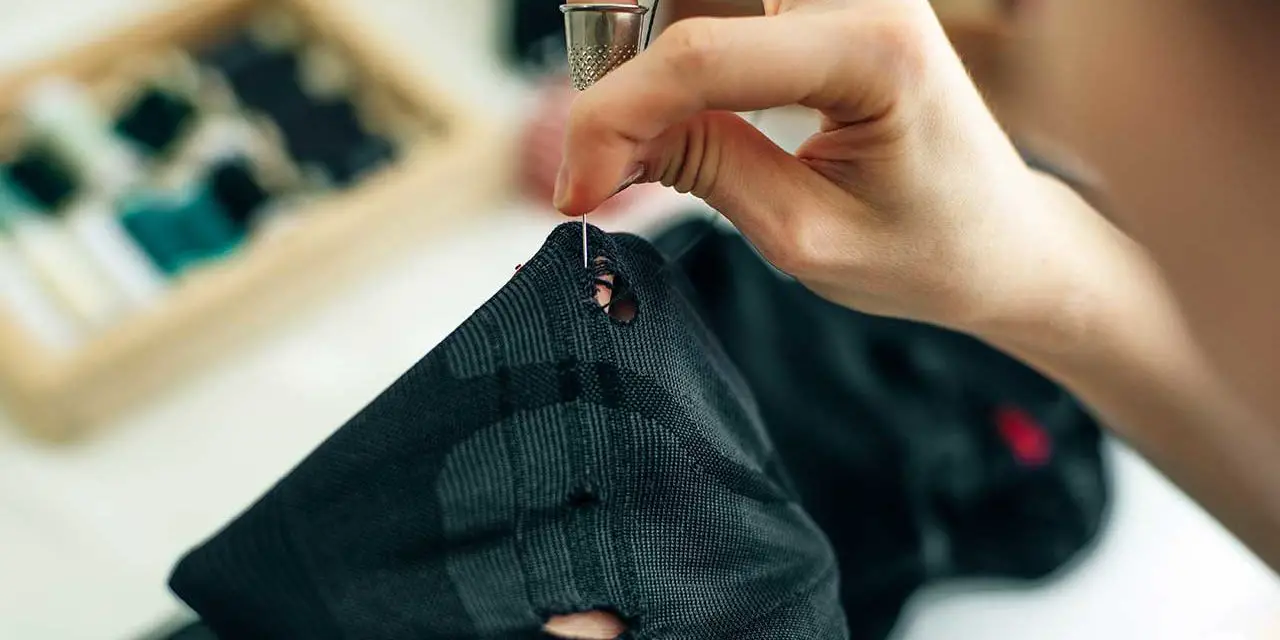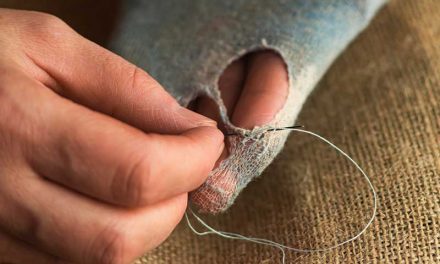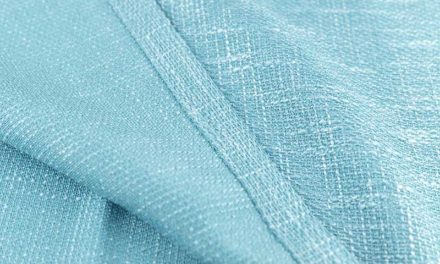Jeans are a comfortable piece of clothing. There’s no denying that, but if you wear them a lot, you could end up with a hole somewhere in the material. They’re so comfy that you don’t want to get rid of them so what do you do? Well, the answer is easy. All you have to do is make a simple repair. If the hole is quite big you will probably need to sew a patch on it. This can be matching your jeans, but you might want to make a statement and use a patterned patch. It will make you look stylish and different. If the hole is small, you can just use a needle and thread to mend it. They will look almost as good as new.
Table of Contents
Sewing a Patch on a Large Hole
Trim Away the Frayed Edges
If you have a large hole in your jeans, they are bound to have frayed edges so the first thing to do is to trim them away. Be careful while you are doing this as you don’t want to cut into the fabric of the jeans. That would mean that you would have to make an even bigger patch. Make sure that you use sharp scissors otherwise you will probably have a problem cutting the edges.
Cut Out the Patch
The next thing to do is to cut out the patch. You will probably want denim, but if you want something snazzy, that’s fine. To get the right size of the patch, measure across the hole on one side and then the other. Add an inch to each measurement which will ensure that the patch will go a little way past the edge of the hole. You don’t want to have a gap in between the patch and the jean material.
As an example, if the hole measures four inches by five inches, you will need a patch that measures five inches by six inches.
Another important thing to note is if the fabric isn’t strong around the hole, make the patch a bit bigger so that you can sew it into stronger material.
You will also need to finish the edges of the fabric with pinking shears. This stops the edges from fraying even more.
Glue or Pin the Edges
The next step is to either glue the edges or to pin them. If you are gluing them, then don’t put the glue much more than 0.5 inches otherwise you might be able to see the glue. If you do decide to pin the patch, remember to remove each pin when you are sewing the patch. In reality, gluing the patch is probably the best option.
You now have two choices. Either you put the patch underneath the hole, or you put it above. If you put it below, you probably want it to blend in with the denim, but if you want to make a fashion statement with the patch, put it above the denim. If you intend to put the patch underneath the hole, put the glue on top of the patch. If you want to put the patch on top of the hole, put the glue on the bottom of the patch.
Sew the Patch
When it comes to sewing the patch onto your jeans, sew around the edges. If you are using a sewing machine, set it to zigzag which gives you virtually invisible stitches. If you are hand sewing, sew your patch in place with a strong needle that can go through denim easily. To make the stitches invisible, use very small stitches.
If you have pinned the patch, be careful to remove the pins before you sew over the patch. It’s easy to do this if you are stitching by hand, but you have to be more careful when using a sewing machine as it works quickly. Glue is probably the best choice if you are using a sewing machine.
Sewing a Small Hole
It is a completely different matter if you are sewing a small hole in your jeans and we will take a look at how to do this now.
Trim Away the Frayed Edges
If you have a hole in your jeans, the edges of the hole are likely to be frayed. The first thing to do is to trim the frayed edges. This will both make it look tidier, but will also make it easier to sew and reduce the visibility of the thread. Make sure that you don’t cut the denim when you are cutting the frayed edges otherwise you could well make a bigger hole.
Sewing the Hole
You need to use thread that is close in color to your jeans; a light blue if you have faded jeans, or a dark blue if your jeans are darker. You need to have approximately 36 inches of thread and this you thread through the needle. Tie a knot at the end so the sewing will be secure.
Insert the needle about 0.5 inches from the side of the hole and anchor the thread in place. If the denim around the hole is weak, feel free to insert the needle a little further, even an inch if needed.
Start sewing stitches from 0.25 inches from the top of the hole down to 0.25 inches from the bottom. Use as small stitches as you can so that they will be almost invisible. Work all around the hole, in and out of the denim, and from side to side. After a few stitches, tug on the thread. This will help to close the hole. Keep doing this until you reach the end of the hole. When you reach 0.5 inches from the other side of the hole, tie off the thread in the inside of the jeans so that it won’t be seen. A double knot is the best for securing the thread.
Conclusion
Both ways of sewing up a hole in jeans are relatively easy and nothing is stopping you from putting a patch on a smaller hole if you fancy making a statement.





